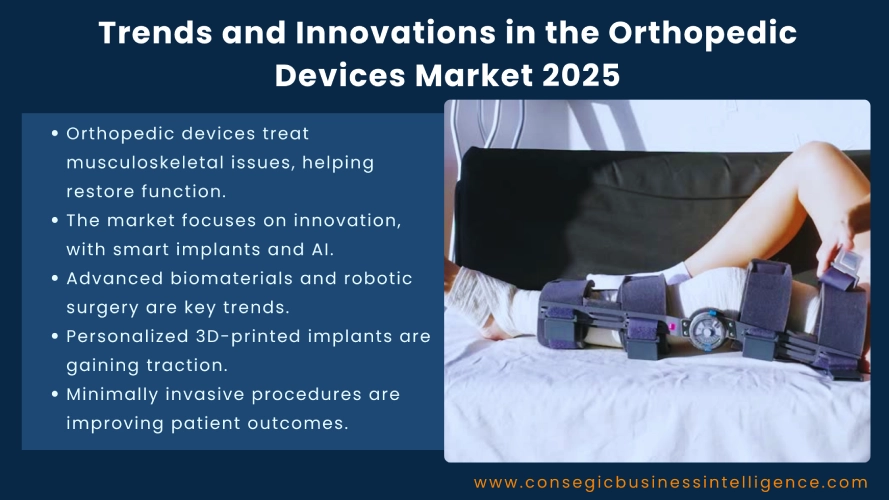Trends and Innovations in the Orthopedic Devices Market 2025
Orthopedic devices are medical instruments used to prevent or treat musculoskeletal injuries. These devices are used for injuries caused by factors such as sports, accidents, aging, and conditions like osteoporosis. Orthopedic devices, including braces, implants, and splints, help to support or replace the injured muscle, bone, or cartilage, thus restoring the function of the particular part of the body.

In recent years, dietary habits have changed, leading to an unhealthy lifestyle. This has resulted in weakened bones and muscles, fueling the demand for orthopedic instruments. Moreover, with the aging global population, there is a rise in the prevalence of orthopedic disorders. In addition, individuals who are involved in sports activities, such as football, hockey, and boxing, often encounter injuries, including ligament tears, joint dislocations, and fractures. These factors drive the need for orthopedic instruments to restore the function of the injured tissue, thereby fueling the market. Advancements in technologies such as artificial intelligence (AI), Internet of Things (IoT), robotics in surgeries, and smart implants have led to innovations in orthopedic devices.
This blog highlights the trends and latest innovations driving the orthopedic devices market in 2025.
Trends and Innovations in the Orthopedic Device Market
AI and Robotics: Precision Redefined in Surgeries
AI-powered diagnostic predictive analytics is used for the early detection of orthopedic conditions. AI algorithms are used to analyze medical images, such as X-rays and MRIs, for the detection of conditions such as fractures and arthritis, thereby enhancing efficiency and accuracy in orthopedic care. For instance, AIIMS Patna recently employed robotics and AI in the orthopedic surgeries for the treatment of their patients, owing to its high accuracy. Moreover, AI helped the doctors detect complex patterns of medical images, thus ensuring proper treatment for the patients.
Furthermore, the integration of robot-assisted technology in orthopedic surgery has revolutionized the orthopedic device market. Moreover, robots such as the MAKO robotic system and the Navio surgical system are being employed in joint replacement surgery, enabling precise bone cutting and accurate placement of implants. This has proved to be beneficial in the orthopedic device industry, making it easier for doctors to perform surgeries with ease and for patients to regain the joint's functionality.
The Ascent of Smart Implants and Connected Devices
Smart implants are devices equipped with sensors and microchips, capable of enabling wireless communication between devices. Integrating smart implants with IoT sensors in orthopedic devices enables the real-time data collection and analysis of the instrument. Furthermore, these smart devices facilitate smart monitoring of the patient's health as well as the implants. The aim is to improve the treatment of the individual diagnosed with an orthopedic condition. This has resulted in increased patient satisfaction, thus escalating the market.
Integration of AI and IoT in orthopedic devices has proved to be beneficial for doctors to diagnose the condition of the patients accurately, as well as keep track of the smart implants, leading to the growth of the industry.
The Expansion of Telehealth
There is a widespread adoption of telehealth and digital platforms in the orthopedic devices market. Telehealth has gained importance in orthopedics for pre-operative consultations as well as for post-operative follow-ups and remote monitoring of recovery. These virtual appointments are helping patients connect with specialists, thereby increasing their significance.
Advanced Biomaterials and Regenerative Approaches
Another emerging trend in the orthopedic device market is the adoption of biomaterials and regenerative approaches. Although conventional materials such as titanium and stainless steel are still the most commonly used, surgeons are progressively adopting biomaterials, which are considered the next generation of materials. These biomaterials are designed to enhance longevity and feature excellent biocompatibility, aiding in faster healing.
For instance, magnesium alloy is used for its excellent characteristic of biodegradability. It dissolves naturally once it has fulfilled its role. Furthermore, regenerative approaches, such as stem cell therapy and platelet-rich plasma (PRP) injections, are used for multiple orthopedic conditions, including osteoarthritis, cartilage defects, and ligament injuries. Moreover, materials such as composite polymers and ceramics are being researched, as they play an active role in supporting bone growth, leading to further innovations in the orthopedic device market.
Conclusion
The need for orthopedic devices is rising with the increase in the aging population, as well as individuals involved in sports. With increasing demand, there have been technological enhancements in the orthopedic instruments, such as robotics for performing surgeries, integration of AI and IoT in devices for accurate analysis of medical images and monitoring of the devices, integration of telehealth, and advanced biomaterials and regenerative approaches. Incorporation of such advanced technologies has enabled doctors to diagnose the orthopedic condition of the patient accurately, thus providing proper treatment. In addition, the patients are satisfied with the treatment and devices used to restore the functionality of the injured body part.
These trends and innovations in the orthopedic device market have revolutionized the industry, leading to its rapid growth.
